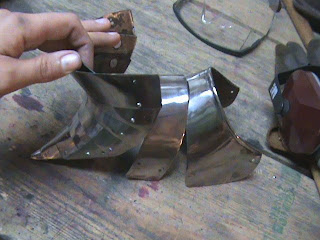Left Assembly part 1
A lot of the scratches were around the rivet holes from grinding them out after firing. That took a bunch of time. Using washers would probably help some there. There are also small dents near the rivet holes which I'm not entirely sure the cause of. It's likely they're local deformations due to parts cooling at different rates. They weren't there before I fired the sabaton, and they're in there now. They're also an extra pain to clean forge scale out of.


I'm thinking that doing rods across the sabaton with wire wrapping may be the best way to fire them. These guys have gaps from the lames separating during the firing and quench. They're not so severe that most folks would notice them, but I'm not happy about it. The articulation did end up quite smooth firing them that way though.
This was the product of a little more than an hour of work. I did a little work with the red Gator wheel, a bit with the blue, which seemed to be doing more to melt itself onto the lames than really smooth things out, and a bunch of polishing on the bench wheel with Black Magic rouge. Once I got the forge scale off things really went fairly fast.
There are some holes which I added a bit late in the game which are now visible. They're based on the lacing holes near the toe seen in this fragment of Philip the Bold's effigy:

Remember that the St. George effigy I'm trying to reproduce was commissioned by Philip the Bold. This sabaton was part of a piece commissioned by John the Fearless to commemorate Philip the Bold shortly after his death in 1404. There's a surviving contract of that commission between John and Claus Sluter dated July 11th, 1404, though Sluter died in 1406 before completing the piece so it was finished by his nephew, Claus de Werve.
It's discreet, but there's a strap that goes under the foot and an associated rivet. I've added holes for that, and hopefully the placement will be OK.
The Chartres sabatons also have holes in the top for lacing:



I'm thinking that doing rods across the sabaton with wire wrapping may be the best way to fire them. These guys have gaps from the lames separating during the firing and quench. They're not so severe that most folks would notice them, but I'm not happy about it. The articulation did end up quite smooth firing them that way though.
This was the product of a little more than an hour of work. I did a little work with the red Gator wheel, a bit with the blue, which seemed to be doing more to melt itself onto the lames than really smooth things out, and a bunch of polishing on the bench wheel with Black Magic rouge. Once I got the forge scale off things really went fairly fast.
There are some holes which I added a bit late in the game which are now visible. They're based on the lacing holes near the toe seen in this fragment of Philip the Bold's effigy:

Remember that the St. George effigy I'm trying to reproduce was commissioned by Philip the Bold. This sabaton was part of a piece commissioned by John the Fearless to commemorate Philip the Bold shortly after his death in 1404. There's a surviving contract of that commission between John and Claus Sluter dated July 11th, 1404, though Sluter died in 1406 before completing the piece so it was finished by his nephew, Claus de Werve.
It's discreet, but there's a strap that goes under the foot and an associated rivet. I've added holes for that, and hopefully the placement will be OK.
The Chartres sabatons also have holes in the top for lacing:


Comments